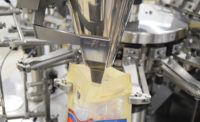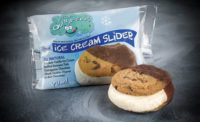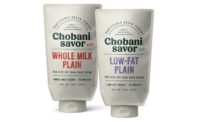The use of flexible packaging continues to grow, thanks to the format’s light weight, shelf impact and more. And with that growth come advances that are bringing new benefits to dairy processors.
One such advance is for foodservice and bulk products using the bag-in-box format. A rigid rectangular dip strip improves yield by maximizing product evacuation from puncture-resistant DuraBev nylon laminate bags.
The EvacuStrip technology from Rapak North America, part of DS Smith Plastics, Romeoville, Ill., enables 99.6% evacuation in any orientation and cuts product residual and waste to almost zero. Measuring 13 or 18 inches, the dip strip works especially well with highly viscous liquids, the company said.
A new retail pouch option, meanwhile — the Tetra Fino Aseptic 100 Ultra MiM package from Tetra Pak, Denton, Texas — makes it possible for dairies to serve the $72 billion global ice cream market without additional investment in production equipment and chilled distribution. Products are filled in aseptic carton pouches, distributed at room temperature and frozen at home or point of sale, the company noted.
For flexible options’ secondary packaging, the interest in retail-ready packaging “has never been higher,” said Peter Fox, vice president of sales for Somic America Inc., which is in the process of moving its headquarters to Eagan, Minn., from Bensenville, Ill., where its parts and service department remains. Fox said the transition to retail-ready packaging is a result, in part, to Walmart’s push to eliminate pegboard displays in the dairy case.
“It also has found its way into the chunk cheese and other areas of non-pegged items,” he said. “The most effective [design] is the two-piece retail-ready package. This enables the producer to use different materials for the display vehicle, typically a tray with retail graphics.”
The cover, or hood, can be lower-cost kraft corrugated like that typically used for standard cases. This way, producers can invest in tray graphics and substrates that will maximize shelf impact while controlling packaging material costs. In addition, the two-piece design is easier to stock on store shelves.
“Removing a cover from a tray is intuitive; no instructions are required,” Fox said. “Some of the single-piece, tear-apart boxes are pretty complicated and difficult ... to quickly open with good results. These [one-piece] retail-ready packages tend to look like someone ripped the box apart.”
Machine advances
On the packaging line, flexible packaging machinery innovations encompass primary and distribution packaging. For primary packaging, Rick Leonhard, president of Viking Masek Global Packaging Technologies, Oostburg, Wis., reported that the use of premade pouches is growing. To serve that need, his company developed a robotic pick-and-place module for its Viking Solpac premade pouch machine.
The robotic system picks up and places pouches one at a time on the infeed conveyor, eliminating the need for operators to manually shingle pouches on the infeed, a task that is difficult to do consistently. Precise placement ensures accurate alignment in the grippers of the Solpac machine.
A vision system confirms positioning, he noted. Should misalignment occur, the scale doesn’t fill. As a result, no product falls outside the pouch; no pouches are wasted; and rejects caused by off-kilter shingling are eliminated.
And Allen-Bradley servo technology from Rockwell Automation, Milwaukee, further simplifies operation of the rotary pouch machine. Size changes are accomplished by selecting the proper program on the operator interface, which automatically adjusts the grippers.
“The servo controls keep the entire operation very simple so you don’t need highly skilled operators to successfully run the machine and send product out the door,” Leonhard said.
And with many companies shipping both conventional and retail-ready cases, it’s essential that case-packing equipment possess the flexibility to run different formats. The compact 8-by-15-foot Somic 424 T2(D) all-in-one packaging system collates product in an upright, display-ready configuration or in a lay-flat configuration for standard shipping cases. The case or display tray is formed around the product while it is held securely in a forming cassette.
“This ensures product protection while wrapping a tight case or tray around the product,” Fox said.
After the tray or case is formed, a cover is formed and applied to the tray or the wraparound case is closed.
The modular Somic 424 base machine offers other advantages, too. It can be configured to handle both rigid and flexible packages. For hand-packing operations, the cover applicator can be installed as a standalone unit. The cover applicator also may be integrated into existing case packing equipment to apply easy-to-remove covers to produce retail-ready packaging.
“Covers are very difficult to assemble by hand and place over a tray,” Fox said. “[The Somic 424 machine] combines the forming and placing process so the covers are tightly secured to the tray, making for a stronger, more efficient shipping unit.”





